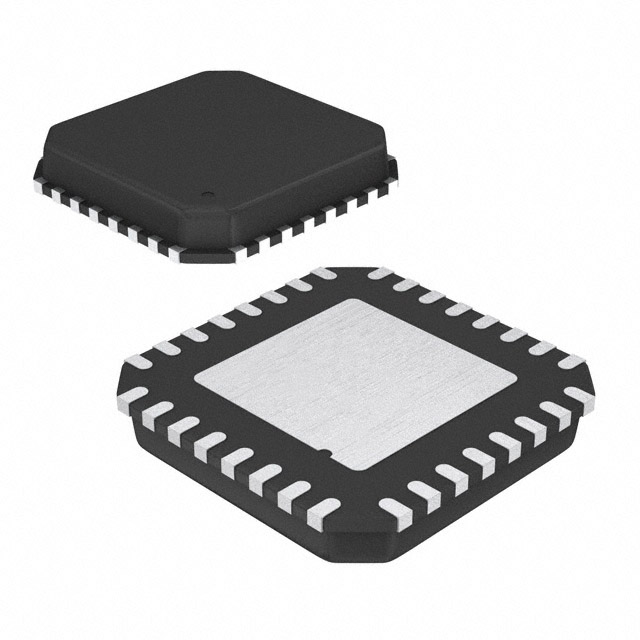Xem thông số kỹ thuật để biết chi tiết sản phẩm.

ATTINY26-16MQ
Product Overview
Category
The ATTINY26-16MQ belongs to the category of microcontrollers.
Use
It is primarily used for embedded systems and low-power applications.
Characteristics
- Low power consumption
- High performance
- Small form factor
- Integrated peripherals
Package
The ATTINY26-16MQ comes in a compact MQ package.
Essence
This microcontroller combines high performance with low power consumption, making it suitable for various applications.
Packaging/Quantity
The ATTINY26-16MQ is typically packaged in reels or tubes, with a quantity of 2500 units per reel.
Specifications
- Microcontroller architecture: AVR
- CPU speed: 16 MHz
- Flash memory: 2 KB
- RAM: 128 bytes
- EEPROM: 128 bytes
- Digital I/O pins: 20
- Analog input channels: 8
- Communication interfaces: SPI, I2C, UART
Detailed Pin Configuration
The ATTINY26-16MQ has a total of 20 pins, each serving a specific purpose. The pin configuration is as follows:
- RESET - Reset pin
- PA0 - Analog input / Digital I/O
- PA1 - Analog input / Digital I/O
- PA2 - Analog input / Digital I/O
- PA3 - Analog input / Digital I/O
- PA4 - Analog input / Digital I/O
- PA5 - Analog input / Digital I/O
- PA6 - Analog input / Digital I/O
- PA7 - Analog input / Digital I/O
- GND - Ground
- XTAL1 - Crystal oscillator input
- XTAL2 - Crystal oscillator output
- VCC - Power supply
- PB0 - Digital I/O
- PB1 - Digital I/O
- PB2 - Digital I/O
- PB3 - Digital I/O
- PB4 - Digital I/O
- PB5 - Digital I/O
- PB6 - Digital I/O
Functional Features
- Low power consumption allows for extended battery life in portable devices.
- High-performance CPU enables efficient execution of complex tasks.
- Integrated peripherals such as SPI, I2C, and UART facilitate communication with other devices.
- Ample digital and analog I/O pins provide flexibility for various applications.
Advantages and Disadvantages
Advantages
- Low power consumption extends battery life.
- Compact form factor allows for integration into small devices.
- High-performance CPU enables efficient processing.
- Integrated peripherals simplify device connectivity.
Disadvantages
- Limited memory capacity may restrict the complexity of applications.
- Lack of advanced features compared to more powerful microcontrollers.
Working Principles
The ATTINY26-16MQ operates based on the AVR microcontroller architecture. It executes instructions stored in its flash memory, utilizing its CPU to perform various tasks. The microcontroller communicates with external devices through its integrated peripherals, enabling data exchange and control.
Detailed Application Field Plans
The ATTINY26-16MQ finds applications in various fields, including but not limited to: - Home automation systems - Industrial control systems - Consumer electronics - Internet of Things (IoT) devices - Sensor networks
Detailed and Complete Alternative Models
Some alternative models that offer similar functionality to the ATTINY26-16MQ include: - ATTINY25-20PU - ATTINY45-20SU - ATTINY85-20PU
These models share comparable specifications and pin configurations, providing alternatives for different project requirements.
In conclusion, the ATTINY26-16MQ is a versatile microcontroller suitable for low-power embedded systems. Its compact size, high performance, and integrated peripherals make it an excellent choice for various applications in different fields.
Liệt kê 10 câu hỏi và câu trả lời thường gặp liên quan đến ứng dụng ATTINY26-16MQ trong giải pháp kỹ thuật
Sure! Here are 10 common questions and answers related to the application of ATTINY26-16MQ in technical solutions:
Q: What is ATTINY26-16MQ? A: ATTINY26-16MQ is a microcontroller from the AVR family, manufactured by Microchip Technology. It offers low power consumption and is suitable for various embedded applications.
Q: What is the operating voltage range of ATTINY26-16MQ? A: The operating voltage range of ATTINY26-16MQ is typically between 2.7V and 5.5V.
Q: How many I/O pins does ATTINY26-16MQ have? A: ATTINY26-16MQ has a total of 20 I/O pins, which can be used for various purposes such as digital input/output, analog input, PWM output, etc.
Q: What is the maximum clock frequency supported by ATTINY26-16MQ? A: ATTINY26-16MQ can operate at a maximum clock frequency of 16 MHz.
Q: Can ATTINY26-16MQ be programmed using the Arduino IDE? A: Yes, ATTINY26-16MQ can be programmed using the Arduino IDE with the help of an appropriate hardware programmer or bootloader.
Q: What programming languages can be used to program ATTINY26-16MQ? A: ATTINY26-16MQ can be programmed using C/C++ language with the help of development tools like Atmel Studio, AVR-GCC, or Arduino IDE.
Q: Does ATTINY26-16MQ have built-in EEPROM memory? A: Yes, ATTINY26-16MQ has 256 bytes of built-in EEPROM memory, which can be used for storing non-volatile data.
Q: Can ATTINY26-16MQ be used for wireless communication? A: Yes, ATTINY26-16MQ can be used for wireless communication by connecting external modules like RF transceivers or Bluetooth modules to its I/O pins.
Q: What is the maximum current that can be sourced/sunk by an I/O pin of ATTINY26-16MQ? A: Each I/O pin of ATTINY26-16MQ can source/sink a maximum current of 20 mA.
Q: Are there any development boards available for ATTINY26-16MQ? A: Yes, there are development boards available specifically designed for ATTINY26-16MQ, which provide easy prototyping and programming options.
Please note that these answers are general and may vary depending on specific implementations and configurations.

